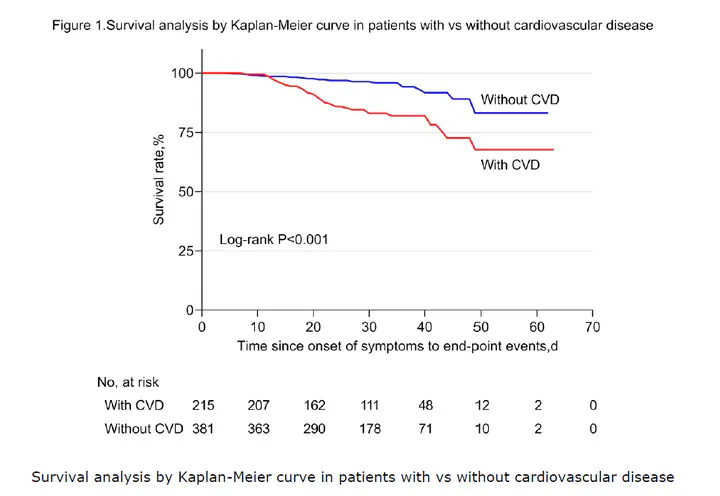
Abstract
Background: Cardiovascular disease (CVD) was in common in Coronavirus Disease 2019
(COVID-19) patients and associated with unfavorable outcomes. We aimed to compare the
clinical observations and outcomes of SARS-CoV-2-infected patients with or without CVD.
Methods: Patients with laboratory-confirmed SARS-CoV-2 infection were clinically
evaluated at Wuhan Seventh People’s Hospital, Wuhan, China, from January 23 to March 14, 2020. Demographic data, laboratory findings, comorbidities, treatments and outcomes were
collected and analyzed in COVID-19 patients with and without CVD.
Results: Among 596 patients with COVID-19, 215 (36.1%) of them with CVD. Compared
with patients without CVD, these patients were significantly older (66 years vs 52 years) and
had higher proportion of men (52.5% vs 43.8%). Complications in the course of disease were
more common in patients with CVD, included acute respiratory distress syndrome (22.8% vs
8.1%), malignant arrhythmias (3.7% vs 1.0%) including ventricular tachycardia/ventricular
fibrillation, acute coagulopathy(7.9% vs 1.8%), and acute kidney injury(11.6% vs 3.4%). The
rate of glucocorticoid therapy (36.7% vs 25.5%), Vitamin C (23.3% vs 11.8%), mechanical
ventilation (21.9% vs 7.6%), intensive care unit admission (12.6% vs 3.7%) and mortality (16.7%
vs 4.7%) were higher in patients with CVD (both p < 0.05). The multivariable Cox regression
models showed that older age (≥65 years old) (HR 3.165, 95%CI 1.722-5.817) and patients
with CVD (HR 2.166, 95%CI 1.189-3.948) were independent risk factors for death.
Conclusion: CVD are independent risk factors for COVID-19 patients. COVID-19 patients with CVD were more severe and had higher mortality rate, early intervention and vigilance
should be taken.